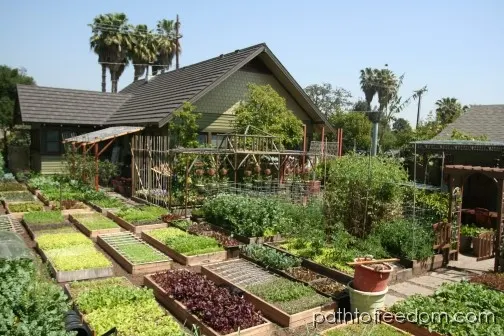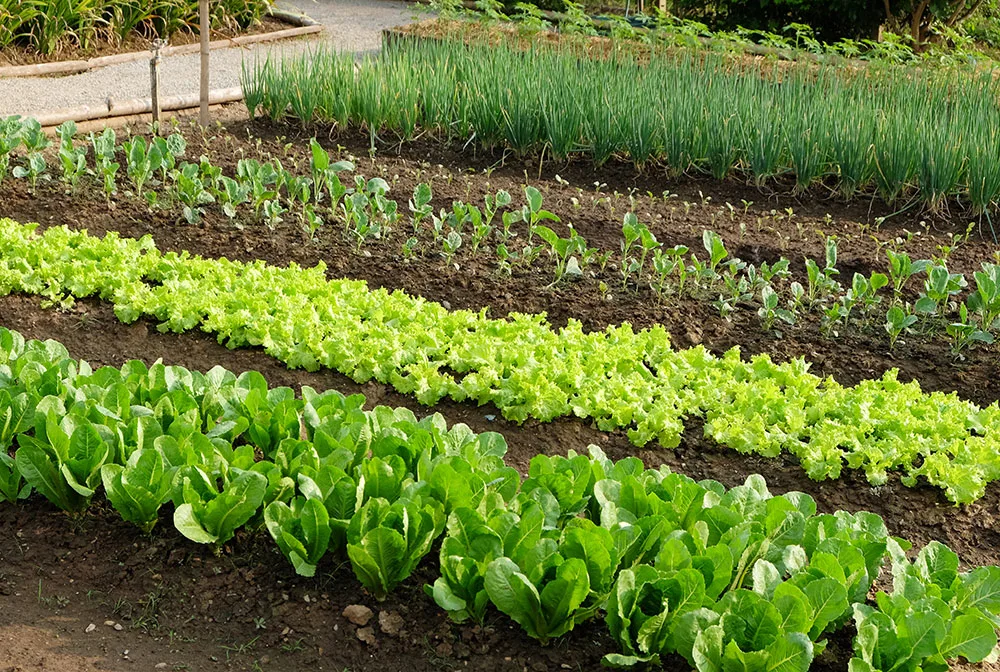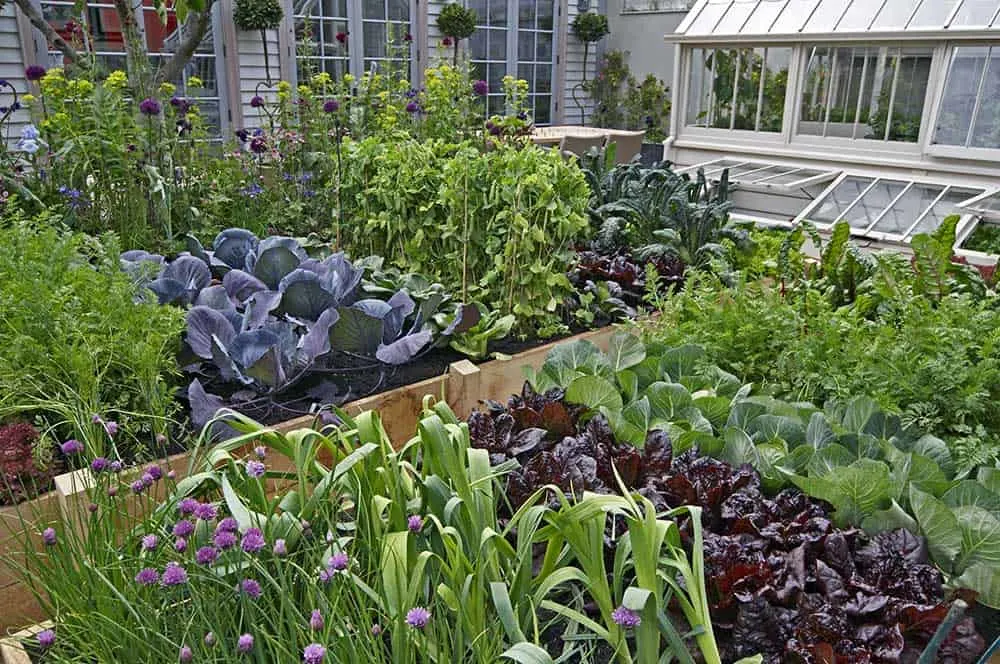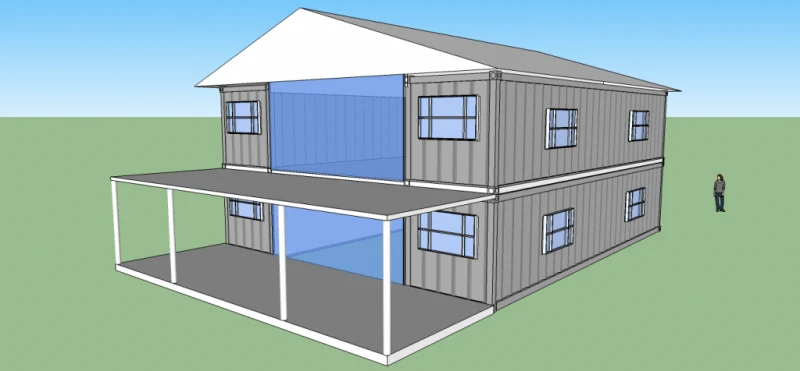Would you believe it’s possible to grow 60,000lbs of organic fruits and veggies per acre? According to Urbanhomestead.org they can produce approximately 3 tons of food annually (2009) on only 1/10 of an acre in their urban yard. If conditions are ideal, scaling this method up could result in a tremendous amount of food per acre.
The Urban Homestead model at a Glance
Location: Northwest Pasadena, one mile from downtown Pasadena [California]
Property Size: 66’ x 132’ = 8,712 sq.ft. (1/5 acre)
House: Simple, wood frame craftsman bungalow. Circa 1917.
House Size: 1,500 sq. ft.
Garden Size: ~ 1/10 acre (3,900 sq.ft. / ~ 66′ x 66′)
Garden Diversity: Over 350 different vegetables, herbs, fruits & berries
Productivity: Up to 6,000 lbs harvest annually on 1/10 acre
SOURCE: http://urbanhomestead.org/urban-homestead

The back yard at the Urban Homestead
Let’s think about this model on a larger scale. Scaling this up could, in theory, produce 60,000 lbs of food annually on just 1 acre of land.
60,000lbs of organic food!
The average American family of 4 consumes about 4 tons (8000 lbs) of food annually. 1 acre of land (208ft X 208ft) farmed like this and scaled up, could (theoretically) support 7.5 families – 30 men, women, and children for a full year!
Imagine being able to feed 30 men, women, and children with food grown on just 1 acre of land!
There are 43,560 square feet per acre of land. If you’re capable of producing 60,000lbs of food, that equates to almost 1.4 pounds of organic food per square foot!
Numbers don’t lie. And this is a real-world application with the proof it works.
Let’s take this up a notch.
Of course, you’d have to buy another acre of land to build your house on, but technically that would be enough space to build one HUGE 43,560sqft home. That’s big enough to allow 20-30 people to live very comfortably. But that’s not very realistic now is it?
On that second acre of land, you could technically build eight 2560sqft Shipping Container Homes, each sitting on 1/8 of an acre 5445sqft (approximately a 73.79ft x 73.79ft square).
That’s a nice chunk of land and lots of square footage in excess of the 1280sqft footprint of each home. Each home has a footprint of 40ft x 32ft.
That leaves about 4165sqft of land around each home, or a strip of land 17ft deep in the front and rear of the building and a 21ft wide strip of land on either side of the home (42ft between homes).
Even with 8 homes on the extra 1 acre of land, that leaves a whopping 33,320sqft of land to grow more food on. This is enough empty land to produce an ADDITIONAL 45,981lbs of organic fruits and veggies.

WindAwake | Shutterstock
Including the original 60,000lbs of food produced on the first acre, that’s a grand total of 105,981lbs of organic fruits and veggies produced on 2 acres of land with 8 homes, capable of supporting at least 8 families of 4 people each, comfortably for a FULL YEAR, with food left over to preserve and/or sell to generate income.
Of course, this is taking things to the extreme. You may not have enough room to walk in the yards, but you can sure feed a whole bunch of people for a year and make some money to boot.

Gardens by Design | Shutterstock
Also, we need to take climate into consideration. The folks at Urban Homestead live in Pasadena, California. The climate there allows them to grow food pretty much year-round, whereas many parts of the country might only get a good 3 months of the growing season (without greenhouses) before the snow flies. Still, this is an inspiring example for those seeking food freedom!


Could we grow all our food locally? – Sean Opinionated
Sunday 30th of August 2020
[…] 60,000lbs of Organic Food Per Acre!, Off Grid World (2019) […]
60,000lbs of Organic Food Per Acre! | Wilderness and Survival
Sunday 19th of January 2014
[…] via 60,000lbs of Organic Food Per Acre!. […]
Tina
Sunday 7th of July 2013
To back up what another comment said, I live in Canada and we only have 3 months of summer to grow fruit and veggies. Winter is too harsh to grow even the most cold-weather-tolerant food except in a greenhouse (which must be heated, using up money).
However my goal is to provide at least 75% of my produce for at least one month, which is certainly attainable.
Really, we are at the mercy of the elements here, but if you live in a place where year-round growing is possible, go for it!!!
K.M. Perru
Wednesday 20th of March 2013
This is a great post detailing what they are doing over at pathtofreedom.com 's urban homestead project. However, it's a bit of a stretch to propose their methods as a "this could be done way bigger" challenge. It's an excellent ideal to strive for but several pitfalls include:
They've been doing this for over 25 years. That's a lot of trial and error and a lot of sweat equity they've build up in order to have the success they do. It's impractical to think that this type of intensive gardening could be scaled and expected to perform similarly without years of adjustment and many many more man hours. According to the harvest records they provide on their website most years fall under the 6,000 lbs produce.
Pasadena, CA also boasts annual low temps that usually stay above 45 degrees Fahrenheit making it an ideal environment to grow a large selection of edibles year round. Very few places in the U.S. have a year-round growing season. This impacts the ability to get multiple harvests and continued growth in the garden. Midwestern and Northern States are lucky to even be able to grow half of the edible plant species that thrive in Southern California.
The massive community surrounding and supporting this homestead project combined with years of learning, active participation in many high efficiency gardening methods, and of course that year round growing weather have made it into a shining beacon of what hard work and community can achieve in urban homesteading.
All in all it was an informative post and I eagerly jumped over to their website to research further. Still, it would be nice if you backed up your opinions.
"So all this stuff you hear from the “experts” about needing a minimum of 2 acres per family to produce enough food to live off grid is basically BULL$#!+"
Saying the numbers don't lie and then using the numbers ineffectively in equations all while disdaining the "experts" rather than quoting them or pointing to examples is ineffective and spreads poor information. At the very least you should be specific in stating that this plan obviously wouldn't work without years of effort and a very precise climate.
---K.M.Perry